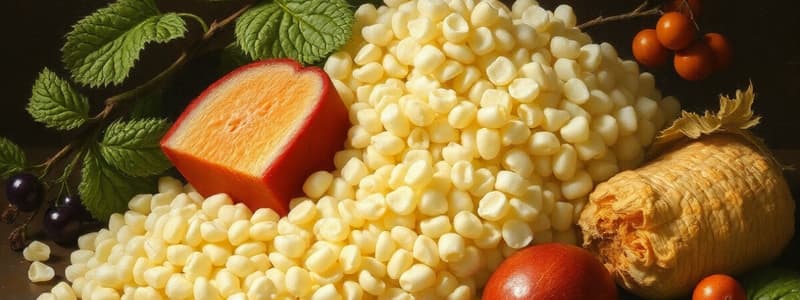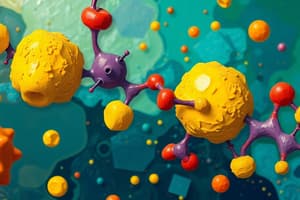Podcast
Questions and Answers
¿Cuál es la estructura típica de un hidrato de carbono?
¿Cuál es la estructura típica de un hidrato de carbono?
- Una cadena de aminoácidos unida por enlaces peptídicos.
- Una cadena hidrocarbonada con grupos carbohidratos y amino.
- Una cadena hidrocarbonada con varios grupos alcohol y un carbono más oxidado. (correct)
- Una estructura lipídica con múltiples ácidos grasos.
¿Qué función principal tienen los hidratos de carbono en las plantas?
¿Qué función principal tienen los hidratos de carbono en las plantas?
- Son responsables de la formación de membranas celulares.
- Sirven como forma de energía y almacenamiento. (correct)
- Participan en la síntesis de proteínas.
- Actúan como catalizadores en reacciones químicas.
¿Qué grupo funcional caracteriza a los hidratos de carbono?
¿Qué grupo funcional caracteriza a los hidratos de carbono?
- Grupos carbonilo y alcohol. (correct)
- Grupos ácido carboxílico.
- Grupos éster.
- Grupos amina.
¿Dónde se forman principalmente los hidratos de carbono?
¿Dónde se forman principalmente los hidratos de carbono?
La cadena hidrocarbonada de un hidrato de carbono está generalmente asociada con qué tipo de grupos?
La cadena hidrocarbonada de un hidrato de carbono está generalmente asociada con qué tipo de grupos?
Flashcards
Carbohidratos
Carbohidratos
Moléculas orgánicas formadas por carbono, hidrógeno y oxígeno; son la principal fuente de energía para los seres vivos.
Función de los carbohidratos
Función de los carbohidratos
Proporcionar energía a los seres vivos.
Estructura de un carbohidrato
Estructura de un carbohidrato
Cadenas hidrocarbonadas con grupos alcohol (-OH) y un carbono oxidado (carbonilo).
Origen de los carbohidratos
Origen de los carbohidratos
Signup and view all the flashcards
Ejemplos de Carbohidratos
Ejemplos de Carbohidratos
Signup and view all the flashcards
Study Notes
Carbohydrates
- Carbohydrates are the most abundant biomolecules on Earth's surface (75%).
- A typical carbohydrate is a hydrocarbon chain with various alcohol groups (-OH) and a more oxidized carbon (carbonyl, 'keto', C=O).
- They are formed in plants from CO2 and in animals from amino acids.
- They are an immediate source of energy (e.g., glucose) for the brain and red blood cells.
- They make up 0.3% of the organism's composition.
- A daily intake of approximately 380g provides 1520 kcal (57.3% from carbohydrate combustion, alongside lipids and proteins).
Classification of Carbohydrates
- Monosaccharides: These are the basic units, containing 3-8 carbon atoms. They cannot be hydrolyzed into simpler sugars. Examples include fructose, glucose, and galactose.
- Oligosaccharides: Formed by connecting monosaccharides. Disaccharides (2 units) like lactose and maltose, and trisaccharides (3 units) like raffinose and maltotriose are examples. (2-10 units).
- Polysaccharides: Composed of numerous monosaccharide units (>10). These can be linear or branched chains. Examples include homopolysaccharides (having one type of sugar) like starch, glycogen and cellulose, and heteropolysaccharides (having multiple sugars).
Monosaccharides: Classification
- Monosaccharides are classified by the number of carbon atoms (trioses, tetroses, pentoses, hexoses, heptoses, octoses).
- The most biologically important are hexoses, followed by pentoses.
- The nature of these molecules can be grouped as aldoses (aldehyde groups) and ketoses (ketone groups).
- The presence of asymmetric carbons results in stereoisomers, which are different spatial arrangements of the same molecule.
Isomerism
- Isomers are compounds with the same molecular formulas but different atom arrangements.
- Structural isomers: These have different structural arrangements (e.g., butane and methylpropane).
- Stereoisomers: These have different spatial arrangements. Further divided into:
- Enantiomers: Non-superimposable mirror images (e.g., (R)- and (S)- isomers).
- Diastereomers: Non-superimposable, non-mirror images (e.g., cis- and trans- isomers).
- Conformational isomers: Different spatial arrangements around single bonds (e.g., different arrangements around a straight carbon chain).
D-Aldoses and D-Ketoses
- D-Aldoses and D-Ketoses are various forms of monosaccharides, differentiated by the position of the carbonyl group. They exist as a chain of carbons that differ in the location of their hydroxyl groups.
- The most common examples: D-glyceraldehyde, D-erythrose, D-ribose, D-arabinose, D-xylose, D-allose, D-altrose, D-glucose, D-mannose, D-gulose, D-idose, D-galactose, and D-talose.
- D-Ketoses are differentiated, having a ketone group versus an aldehyde group. These examples: Dihydroxyacetone, D-erythrulose, D-ribulose, D-xylulose, D-psicose, D-fructose, D-sorbose, and D-tagatose.
Derived Monosaccharides
- Alditols: Formed by reducing the carbonyl group to an alcohol group. Examples: sorbitol, mannitol, and ribitol.
- Deoxy Sugars: Formed by removing a hydroxyl group. Examples: 2-deoxyribose and fucose.
- Amino Sugars: Formed by replacing a hydroxyl group with an amino group. Examples include glucosamine and galactosamine.
- Acidic Sugars: Oxidation of the terminal carbon to a carboxyl group (creating an acid). Examples: glucuronic acid, and gluconic acid.
Disaccharides
- Formed when two monosaccharides join via a glycosidic bond. The most biologically relevant examples are sucrose, lactose, and maltose.
- Important disaccharides include lactose (galactose + glucose), sucrose (fructose + glucose), and maltose (glucose + glucose).
Polysaccharides
- Large polymers of monosaccharides – starch, glycogen, cellulose, and chitin are all polysaccharides.
- Starch: A storage polysaccharide in plants, consisting of amylose (linear) and amylopectin (branched) chains of glucose.
- Glycogen: A storage polysaccharide in animals, highly branched for rapid glucose mobilization.
- Cellulose: A structural polysaccharide in plants, consisting of linear chains of glucose with beta(1-4) linkages. It is indigestible to humans.
- Chitin: A structural polysaccharide in arthropods and fungi, containing N-acetylglucosamine units.
Studying That Suits You
Use AI to generate personalized quizzes and flashcards to suit your learning preferences.




